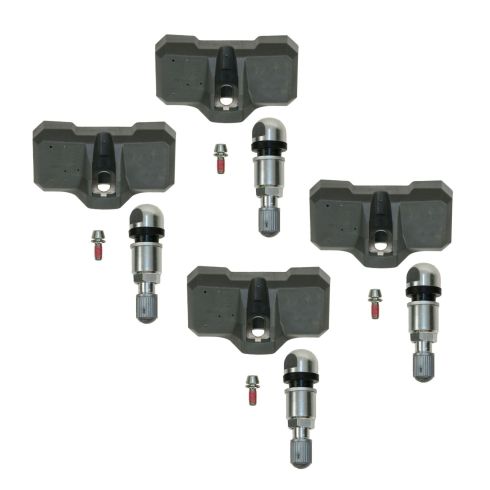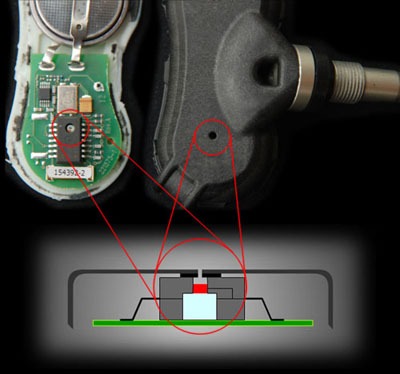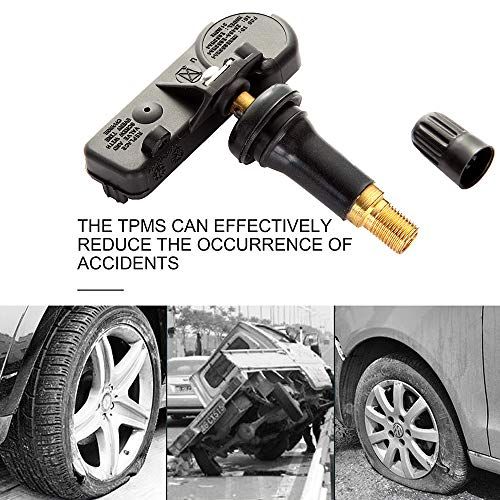Hide Show
Sell/Trade Us Your Car | Click Here To Learn More
Your tire pressure light provides a critical reminder to restore the pressure in your vehicle's tires when it gets low. You should only attempt to reset the light after first addressing the tire pressure in every tire. Once your tires are at the appropriate pressure, the light may go off on its own. If it doesn't go off right away, driving at 50 mph for about 10 minutes should help the tire pressure sensor reset.
If the tire pressure light is still on, there are a few more tricks you can try:
TPMS stands for Tire Pressure Monitoring System. The tire pressure light is one component of this electronic system, providing a visual alert when your tire pressure is low. The TPMS monitors tire pressure using either an indirect or direct method.
An indirect TPMS measures the rate of revolution for each wheel. If a wheel starts spinning faster than anticipated, the system signals to your vehicle's computer that something is amiss with the tire rotation, and your tire pressure light comes on. You must manually reset the monitor in an indirect TPMS system.
A direct TPMS uses pressure monitoring sensors in each tire to monitor tire pressure exactly. This is a more accurate alternative to an indirect TPMS system. The batteries inside these sensors will last for about 10 years. Direct TPMS systems reset automatically after tire inflation or rotation. You do need to have these sensors resynchronized when you get new tires, which requires a special tool.
Yes, cold weather will affect the air pressure in your tires. Your tires lose one or two pounds per square inch (PSI) for every 10 degrees that the temperature drops. Cold air condenses while warm air expands. Therefore, the colder air in your tires will take up less space in lower temperatures.
You may find that your TPMS light is only illuminated for a short time in the morning on particularly cold days. After about 20 minutes of driving, the air will often warm up and expand, restoring proper pressure in your tires. If the light stays on after 20 minutes on the road, you should add air to your tires as needed to restore the proper pressure. Low tire pressure is hazardous for your vehicle regardless of the cause.
If the light stays on after 20 minutes on the road, you should add air to your tires as needed to restore the proper pressure. Low tire pressure is hazardous for your vehicle regardless of the cause.
When the tire pressure monitor light is on, the first thing you should do is check the pressure in each of your tires, including the spare. Check the manufacturer's recommendation to determine the appropriate pressure for each tire. This is typically between 30 and 35 PSI but may vary. You should measure tire pressure when the tires are cold, which means they have not been driven in the last three hours.
To check the pressure, simply unscrew the valve cap and insert a tire gauge into the valve stem. The gauge will provide a clear reading. Replace the valve cap when you're finished. If your tires are all at the appropriate pressure, there's a malfunction with your TPMS. Bring your vehicle to an authorized dealership service center to diagnose and resolve the issue.
If the tire pressure monitor light is on, you should check your tire pressure as soon as possible. Low tire pressure creates a serious hazard on the road. According to the National Highway Traffic Safety Administration, 738 people died in tire-related crashes in 2017. When tire pressure is low, the tire has more contact with the road. This may cause the tire to overheat, leading to tread separation, excessive tire wear, or a blowout.
Low tire pressure also wreaks havoc on your fuel efficiency. You can save up to 11 cents per gallon simply by keeping your tires properly inflated. You'll also save money on tire replacements with adequate inflation. Keeping your tires properly inflated can add 4,700 miles to the tire's average lifespan.
The tire pressure monitor light gives you valuable information and should not be ignored.
You do not necessarily need to have your TPMS sensors replaced with new tires, but this is a good time to check them and make sure they're still in good condition. If you have an indirect TPMS system, your mechanic will need to manually reset the sensors after changing your tires. If you have a direct TPMS system, no additional maintenance is required to reset the system.
If you have an indirect TPMS system, your mechanic will need to manually reset the sensors after changing your tires. If you have a direct TPMS system, no additional maintenance is required to reset the system.
A new TPMS system will typically last for about 10 years before the batteries run out. If you have an older vehicle, you may need new sensors every five or six years. Your mechanic can advise you on the best time to replace TPMS sensors for your vehicle. When new sensors are installed, the system must relearn the location of each tire, which requires a detailed series of technical procedures. You should leave this task to a professional.
If you need tire service for your Toyota, come to Kings Toyota for prompt, reliable service. Our highly-trained technicians are equipped to assist with any type of tire issue, whether you need new tires or have a malfunctioning tire pressure sensor light. Make your appointment today.
First Name*
Last Name*
Contact Me by*
EmailPhone
Hide Show
If you've inflated your tires, but your tire pressure light remains on, this means you may have to reset it. The tire pressure monitoring system (TPMS) on your GMC truck or Cadillac is critical to keeping you and your tires safe while driving around Bozeman or Missoula, so it's important to make sure it's activated and running properly. If you find your TPMS light on but you don't think it should be, take these steps, or bring your vehicle to our tire center at GMC of Billings in Billings, MT.
The tire pressure monitoring system (TPMS) on your GMC truck or Cadillac is critical to keeping you and your tires safe while driving around Bozeman or Missoula, so it's important to make sure it's activated and running properly. If you find your TPMS light on but you don't think it should be, take these steps, or bring your vehicle to our tire center at GMC of Billings in Billings, MT.
Confident that your tires are full at a healthy pressure? Here are some steps you can take to troubleshoot your tire pressure monitor light and reset it.

If none of these steps work, call or vist us from Great Falls to schedule an appointment with one of our service technicians. Or, if you're not confident about handling any of these steps, get in touch with us to help you out with service tips. Better to be safe and have a professional, GMC- or Cadillac-certified technician handle your maintenance if you're unsure of what to do.
A flashing tire pressure light can sometimes be a sign that the battery needs to be replaced, as tire pressure sensors often use the battery. However, a flashing tire pressure light can also signal a problem with one of the sensors.
Determining why your TPMS light won't turn off can be tricky, so we're happy to help you out at our GMC service center near Missoula. Our certified technicians can help you diagnose your tire pressure light issues quickly and at a low rate - especially if you come from Helena to visit our tire center with a service coupon special in hand. Get in touch if you have any questions about the steps outlined above or any other issue, such as how to remove car dents and scratches.
First Name*
Last Name*
Contact Me by*
EmailPhone
GMC of Billings
840 South Shiloh
Billings, MT 59106
Visit us at: 840 South Shiloh Billings, MT 59106
Loading Map. ..
..
; ;
You are an enthusiastic new car owner, the joy of tactile devices, integrated technologies should bring you the ease and comfort of using your Chevrolet Silverado, however, which is to say that the technology is talking about electronic, and, like all of us, to Unfortunately, we often know that there are problems that need to be solved. Today we will look at the tire pressure sensor and exactly how to reset the tire pressure sensor on a Chevrolet Silverado so that you no longer have this indicator on the dashboard. To do this, we will divide our article into two parts: first we will talk about the classic case when the tire pressure indicator appears and the subsequent operation, and then that the tire pressure indicator remains on despite the tires being inflated. So, how to reset this tire sensor on a Chevrolet Silverado.
Today we will look at the tire pressure sensor and exactly how to reset the tire pressure sensor on a Chevrolet Silverado so that you no longer have this indicator on the dashboard. To do this, we will divide our article into two parts: first we will talk about the classic case when the tire pressure indicator appears and the subsequent operation, and then that the tire pressure indicator remains on despite the tires being inflated. So, how to reset this tire sensor on a Chevrolet Silverado.
First, we will look at the general approach to reset a tire sensor on a Chevrolet Silverado which if it lights up, here are the basic basic steps:

 Generally speaking, you need to look at the parameters of the car, then you should find the option to detect inflation or "detect deflation" when in this tab you have to hold down the select button or the reset button depending on the year of your Chevrolet. Silverado until a message appears from the car console confirming that the reset has been taken into account (this usually takes a few seconds). You can now turn off the ignition and restart your Chevrolet Silverado to see if the tire pressure light has gone out.
Generally speaking, you need to look at the parameters of the car, then you should find the option to detect inflation or "detect deflation" when in this tab you have to hold down the select button or the reset button depending on the year of your Chevrolet. Silverado until a message appears from the car console confirming that the reset has been taken into account (this usually takes a few seconds). You can now turn off the ignition and restart your Chevrolet Silverado to see if the tire pressure light has gone out.  However, this procedure is not recommended as it may result in improper handling and malfunction of your Chevrolet Silverado. Now you have all the keys to know how to reset the tire pressure sensor on Chevrolet Silverado.
However, this procedure is not recommended as it may result in improper handling and malfunction of your Chevrolet Silverado. Now you have all the keys to know how to reset the tire pressure sensor on Chevrolet Silverado. For more Chevrolet Silverado tips, take a look at the Chevrolet Silverado category.
You are the proud owner of a recent car, the joy of tactile gadgets, integrated technology should bring you the ease and comfort of using your Chevrolet Cruze, however, that says technology is talking about electronic, and as we all unfortunately often know the problem to be solved. Today we will focus on the tire pressure sensor and specifically the tire pressure sensor. how to reset the tire pressure sensor on a Chevrolet Cruze so that this indicator is no longer displayed on the dashboard. To do this, we will divide our content into two parts: first we will explain the classic circumstance when the tire pressure indicator light appears and the method to follow, and then the circumstances when the tire pressure indicator remains on despite the tires being inflated. so how to reset this tire sensor on chevrolet cruz.
so how to reset this tire sensor on chevrolet cruz.
First we will look at the general approach to reset a tire sensor on a Chevrolet Cruze, which if it lights up, here are the basic steps:
 . If it turns out that this is not the case, we advise you to go through the next section.
. If it turns out that this is not the case, we advise you to go through the next section. Now that you have tried the basic method of removing the tire pressure sensor on the Chevrolet Cruze, and it didn't work, we'll move on to the second solution, which is to have the tires on my Chevrolet Cruze well inflated and I still want that light to go out. This almost certainly means you have Faulty tire pressure sensor. This will require to reset the value on your car's dashboard. However, be careful not to do this while driving as pressure fluctuations will interfere with the pressure sensors. In general, you need to go through the vehicle settings, then you should find the option to detect inflation or "detect deflation", once in this tab, you should hold the select button or the reset button depending on the year of your Chevrolet.